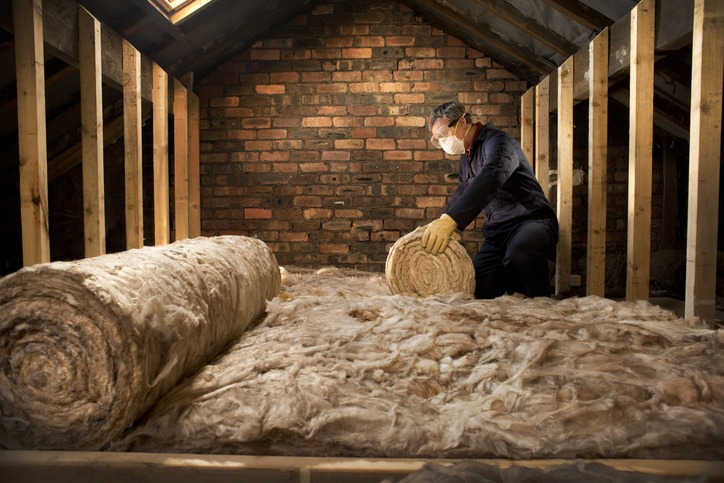As the fall season ushers in cooler temperatures and changing weather patterns, homeowners must prepare their residences to withstand the season’s challenges. One of the most critical aspects of this preparation is ensuring that the roofing system is adequately insulated. Proper roofing insulation contributes to energy efficiency, comfort, and cost savings in residential roofing. Explore the significance of residential roofing insulation during the fall season and its role in maintaining a comfortable, energy-efficient home. Whether you’re a homeowner looking to enhance your understanding or a roofing professional seeking valuable insights, you can learn to make the most of your insulation for the fall and beyond.
What Is Roofing Insulation?
Roofing insulation is a material or combination of materials installed beneath the outermost layer of your roof to reduce heat transfer between the interior and exterior of your home. It acts as a thermal barrier, helping to maintain a stable indoor temperature.
How Does Roofing Insulation Work?
Roofing insulation works on the thermal resistance principle, commonly called “R-value.” The higher the R-value, the greater the insulation’s ability to resist heat flow. In the fall, insulation helps keep indoor heat from escaping through the roof and prevents cold outdoor air from infiltrating the interior.
Fall-Specific Challenges for Residential Roofing
Fall presents specific challenges for residential roofing that make proper insulation even more crucial.
- Temperature Fluctuations: Fall is a transitional season with fluctuating temperatures. Insufficient insulation can lead to discomfort as indoor temperatures struggle to remain consistent.
- Leaves and Debris: Falling leaves can accumulate on roofs, potentially blocking gutters and drains. This buildup can lead to water damage and reduce the lifespan of roofing materials.
- Moisture and Mould: As temperatures drop, the risk of moisture buildup in attics and between roofing layers increases. Moisture can lead to mould growth, rot, and damage to insulation.
- Energy Efficiency: Energy efficiency becomes more critical as homeowners rely on heating systems. Inadequate insulation can lead to increased energy consumption and higher heating bills.
The Impact of Roofing Insulation on Energy Efficiency
Effective roofing insulation is pivotal in maintaining energy efficiency during the fall season.
- Reduced Heat Loss: Proper insulation helps prevent heat from escaping through the roof, ensuring that the warmth generated by your heating system remains inside the home. This results in lower heating costs.
- Preventing Cold Infiltration: Insulation acts as a barrier against cold outdoor air, preventing it from seeping into the home. It not only keeps the indoor environment comfortable but also reduces the workload on your heating system.
- Temperature Regulation: Insulation helps regulate indoor temperatures by reducing the impact of external temperature fluctuations. It creates a more comfortable living environment year-round.
- Condensation Control: In colder weather, condensation can form within roofing structures. Adequate insulation helps control condensation, preventing moisture-related issues such as mould growth and rot.
Signs of Inadequate Roofing Insulation
Recognizing the signs of inadequate roofing insulation is essential for addressing problems promptly. Look out for the following indicators:
- Inconsistent Indoor Temperatures: If you notice significant temperature fluctuations within your home during the fall, it may be due to insufficient insulation.
- High Energy Bills: Increased heating costs, especially during the fall and winter, can indicate poor insulation.
- Drafts and Cold Spots: Drafts and cold spots in specific areas of your home, particularly near the ceiling or roofline, may indicate insulation issues.
- Moisture Problems: If you experience moisture-related issues like condensation, mould growth, or water stains in your attic or on ceilings, it may be linked to inadequate insulation.
Fall Roofing Insulation Maintenance
To ensure your residential roofing system remains energy-efficient during the fall season, follow these essential roofing insulation maintenance steps:
- Inspect Insulation: Inspect the insulation in your attic or roof structure. Check for gaps, damaged insulation, or areas where insulation may have settled over time.
- Seal Gaps and Cracks: Seal gaps or cracks in the attic or roof structure that may allow air infiltration. Common problem areas include around vents, chimneys, and attic access points.
- Clear Debris: Regularly remove leaves, debris, and pests from your attic or roof structure. It prevents blockages and ensures proper airflow.
- Upgrade Insulation: If your insulation is inadequate or outdated, consider upgrading to materials with a higher R-value. Consult with a professional for recommendations.
- Roof and Attic Ventilation: Ensure roof and attic ventilation systems work well. Proper ventilation complements insulation by regulating temperature and moisture.
- Professional Assessment: Periodically assess your roofing insulation by a professional contractor. They can identify issues and recommend appropriate solutions.
Benefits of Proper Roofing Insulation
Investing in proper roofing insulation during the fall season offers numerous benefits for homeowners and their residential roofing systems:
- Energy Savings: Proper insulation can lead to significant energy savings by reducing the need for heating and cooling systems.
- Improved Comfort: Maintaining consistent indoor temperatures enhances overall comfort for residents.
- Enhanced Roof Longevity: Adequate insulation helps protect roofing materials from temperature-related stress, potentially extending their lifespan.
- Moisture Control: Effective insulation helps control moisture, reducing the risk of mould growth, rot, and structural damage.
Homeowners should understand the importance of roofing insulation, recognize signs of inadequate insulation, and follow a maintenance routine that includes inspection, sealing gaps, clearing debris, and considering insulation upgrades when necessary. By investing in proper roofing insulation, homeowners can enjoy an energy-efficient, comfortable living environment during the fall and throughout the year while also extending the lifespan of their residential roofing system.
